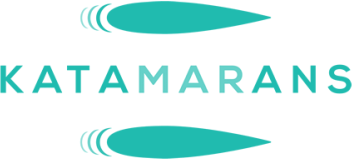Balance 526 Pippilotta with Outer-Passage
We had a great chat with Darren and Amanda from Outer Passage, a blue-water sail training company, on Pippilotta, a Balance 526 that we saw at the Cannes Yachting Festival. They are now in Portugal getting ready for a passage to the Canary Islands and then across the Atlantic.
Here is some great feedback on the Balance 526.
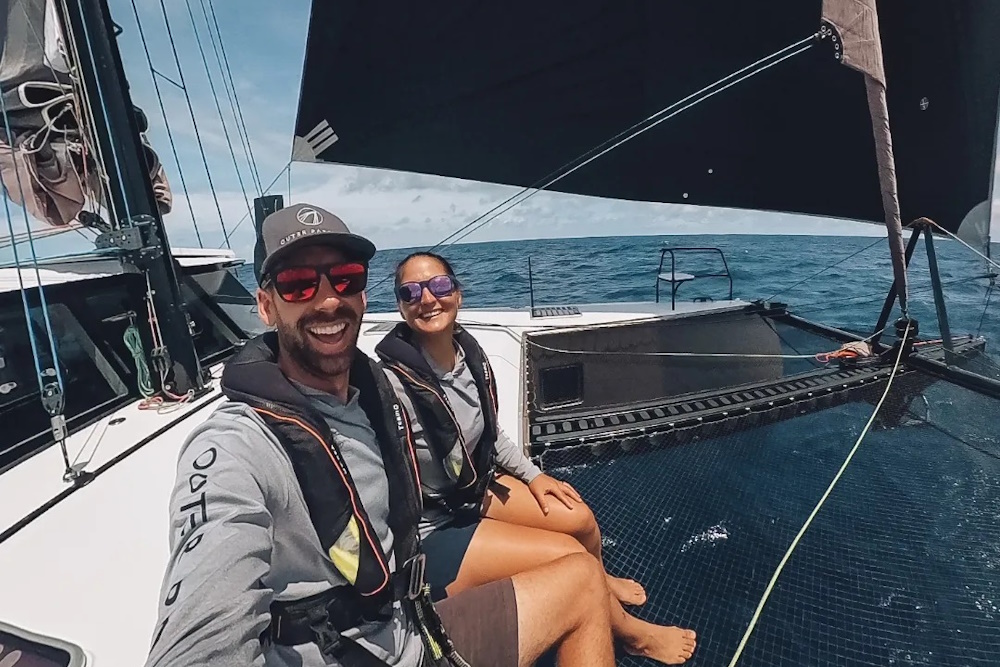
Gideon: “Thanks so much for joining us to talk about Pippilotta, the Balance 526 that you are running your blue-water sail training packages on through Outer Passage!”
“Can we kick things off with a bit more information about Outer Passage and the story behind your business? How you got to where you are now? These kinds of longer-distance sail training packages- there are more and more of them, and it’s a welcome development in my view. So, how did you get into the business?
Darren: “Yeah. It all started with Amanda and I sailing on a monohull some six years ago and we sailed for many years, did some really good passages and saw some great countries. But we came to the end of our sailing sabbatical, and we had to go back to work, but we found we loved life on the water. So we said, “let’s start a sail training business where we’re going to interact with people directly and we figured there’s a lack of multihull sailing experiences for performance yachts. So that’s when we bought a Neel Trimaran and started our business: Outer Passage.
“We’re also unique in that we do everything from Ocean Crossing to Coastal, overnight passages or multi-day passages to day sailing and anchoring up at night and cooking good meals. That sort of thing. So we do a little bit of everything. Then we were looking to transition from our Neel, and this is the story of how we got involved with Balance. We ran our Neel for two years or so and built the business and things were great.”
“We were getting plenty of clients and we also found that many of them were buying Balance Catamarans. They were coming to us for sail training. So I thought: let me send a message to Phil at Balance and say “I think we have a partnership opportunity here because it’s kind of naturally occurring”.
“And after a little discussion, he revealed he had an owner, the owner of Pippi, with whom there might be an opportunity. Where they were, they had some personal delays and they were getting their boat but they couldn’t sail off in it immediately after delivery as they’d planned, so they’re looking for a Plan B.”
“So that’s what gave birth to the Outer Passage partnership program, where we partner with a boat owner. We use the boat for sail training and the owners will come and sail and enjoy their boat as they normally would. We don’t stay on board for that of course.”
“So we found a couple of things with this program. It works well with the owners. We continue to get to do our sail training with a lot of Balance or future Balance Catamaran owners and Balance has a training service for all of their owners that are waiting to buy a boat.”
Gideon: “OK, so that’s interesting. So it’s been driven by the demand that you’ve seen. So is it is it just people who are buying Balance boats or is the market wider than that? And then you’re kind of selling Balance?
Pippilotta Tour
Amanda: “We’re not selling Balance, it’s the other way around. Balance sends us their owners or people that are interested in the brand to see what a Balance can do.”
“So they send them to us so that we can give them training or offer them a day sail, or a tour to see if they’re interested in a Balance in the future. But we also open up to our own customers as we started Outer Passage before the relationship with Balance, of course.”
It’s weighted to Balance owners, of course, but we still open it up to anyone who wants this experience.
Darren: “We have clients buying all kinds of other performance catamarans. So our premise with Outer Passage is that we’re doing sail training on a performance multihull or a performance catamaran, should I say.”
“It just turns out that a lot of them are Balance owners too.”
Rachel: “Which other catamarans are people looking at?
Amanda: “We have a repeat customer coming aboard. More or less on the performance side.
Darren: “We’ve had customers that have Lagoons, Excess. The next customer is an Excess owner” now, too. Yeah, he’s just buying an Excess 15. “
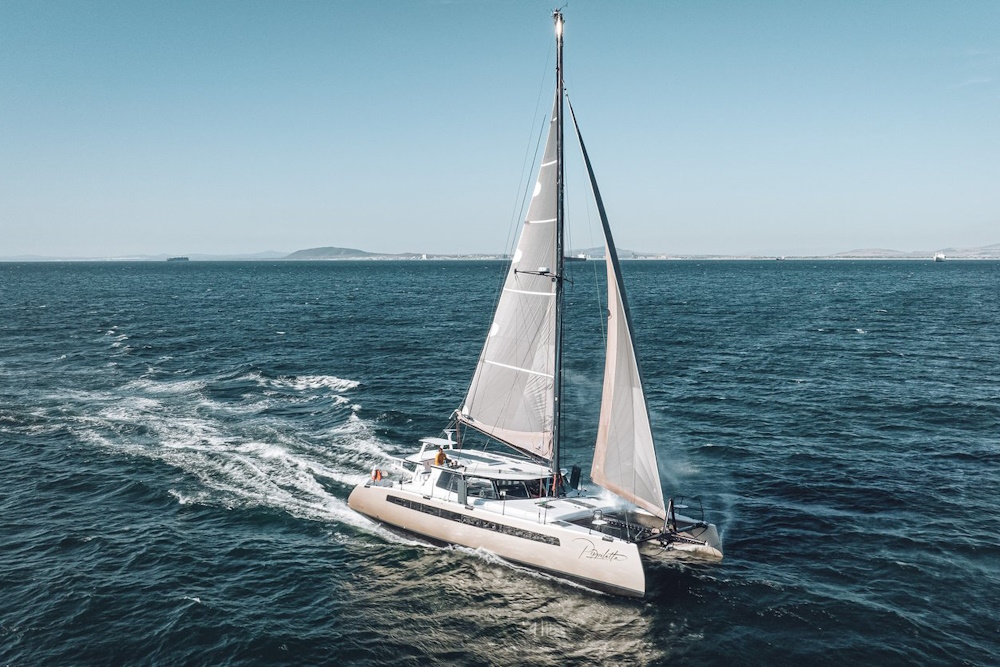
Photo credit: Balance Catamarans
Amanda: “Some people, even if they don’t necessarily want a performance multihull, they want that liveaboard experience. Even if it’s offshore, because when you’re cruising you’re going to be doing offshore passages and coastal cruising so you want to experience both of those. This is the perfect opportunity because when you’re doing a vacation Charter, it’s not going to happen. We try to share our knowledge because we’re liveaboards.
We live on this boat, we don’t have a home base so we can give them that first-hand knowledge: what it is like to anchor up or what happens when a storm comes through and you have to move in the middle of the night, we can share those experiences first-hand.
Gideon: “Is there one thing that you love about the Balance, if you could isolate it? Is it the helm position for example? If you were to try and put your finger on one thing?
Amanda: “It’s solid, the boat feels so comfortable. The build quality, I think. It gives you a sense of security that I was looking for, especially for ocean passages. I feel safe. And I feel comfortable and confident in the build quality, and the boat. And I believe that most people are looking for that, but for me, that stands out.
Darren: “That’s a good point because our first boat was a monohull, an Amel, the French brand, very nice. It was an older boat but even though it was 40 years old at the time, we sailed it in some big conditions and it didn’t squeak or creak. It was a really solid boat because all of the bulkheads were fared in and glassed.”
Amanda: “All of the furniture was glassed in as well. So it has a similar feel in some ways to the Balance. Nothing squeaks down below or creaks and everything is just so well built.”
Darren: “Yeah, I think that’s a highlight, and for me, I was very surprised with the amazing upwind sailing performance. Most people don’t talk about that on a performance cat. They like to think about flying big Spinnakers and going downwind and surfing fast, which of course, she does well, but we have yet to be beat by any boat upwind. We will sail frequently faster than the charter cats motoring straight into the wind. We’ll tack and beat them up to the windward mark when they have both engines on and sails down.”
“That surprised me with this boat, which has very tall daggerboards. I think they are three metres when they’re in the water fully down. And so the upwind grip is incredible and we can point really high so we don’t make a lot of leeway. Yeah, we definitely have less of that.
“We’ve pointed up to 20, 22 degrees. It’s not the best VMG at those kinds of angles but the upwind sailing is amazing.
Gideon: “Apparent? Just thought I would check, I was just thinking that that would be really amazing :)”
Darren: Yeah, apparent LOL. So we did this test where in like 10 knots of Breeze, we can point up to, our best VMG is somewhere around 35 degrees apparent wind angle which is something like 45, 48 to true and the boat does does great. But then, if you need to make a mark or maybe you need to get higher than a boat or a buoy or something, we can still point another 10 degrees higher.
It’s not the fastest, the boat will slow down to three and a half knots or something, but she’ll still move and you still have grip on the rudders. It shows the naval design and the naval architecture was done very well. She’s really well balanced with the centre of effort, with the sails and the daggerboard location.”
“All of those forces allow you to pinch high to the wind. And then you look at your sailing track and it looks like you are going right into the wind. So that’s something that surprised both of us.”
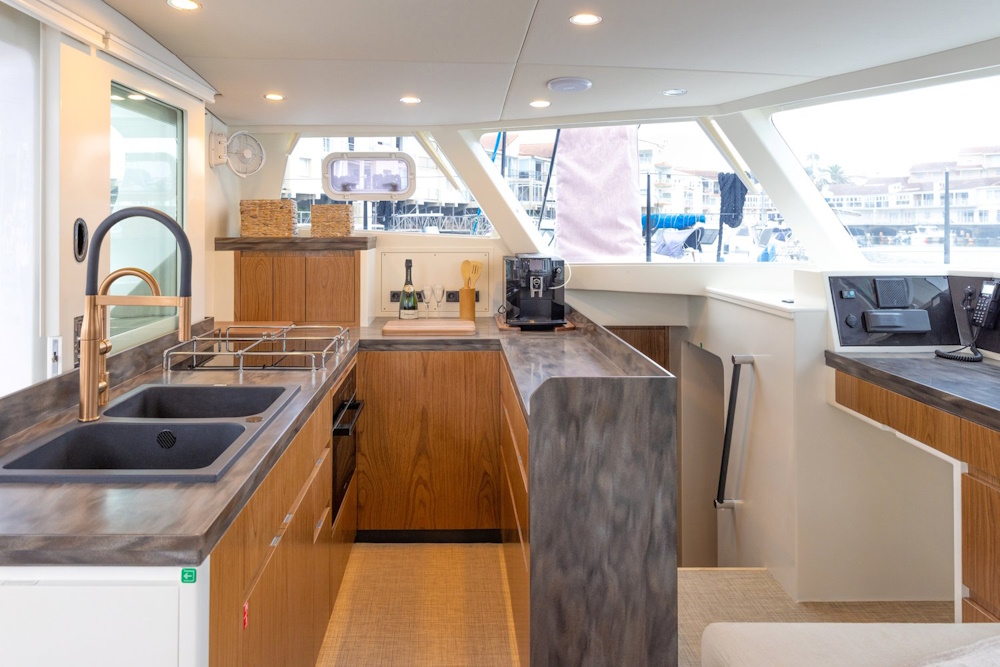
Photo credit: Balance Catamarans
Gideon: “The other thing, there’s always this question when you buy a boat, you have your priority list and you know, some things don’t make the cut. What would be up there in your list of must-haves? In terms of the options I mean. I’m talking about sail options, carbon masts and so on. There are a lot of extras packed on this boat.”
“Are there two or three that you would prioritise, just to to help people who are configuring their boats.
Darren: “You do have to remember we’re not the owners. We know the options list, but we haven’t had to go through it personally and make those decisions, but we do assist future owners in that decision-making process.”
“And so with that, there are a few things that we do recommend. Balance has just this General cruising package where there’s a base level and then some add-ons. And in that package, you get upgraded sails. And you get lines and fenders and other things, but I think the important part of the upgrade is the sail package because you get higher-performance sails from Ullman. They’re a laminate type cruising sail and they perform very well.”
“I think they’re really good value in terms of what their actual cost is, and the sail shape that you get. I think on a boat the size Dacron is not the way to go if you plan to make some miles.”
Amanda: “The Code Zero of course, and for downwind you need a Spinnaker: whatever you prefer, whether that’s an asymm. or symmetrical. It’s up to how someone cruises, of course, and what they’re going to be doing with their boat.
Darren: “Yeah, we highly recommend at least two downwind sails in your locker: the code zero and then, a downwind Spinnaker.
Gideon: “And in the interior, is there anything you can highlight? Is it the hard top Bimini that’s useful for protection? Are there a couple of things you could point out?
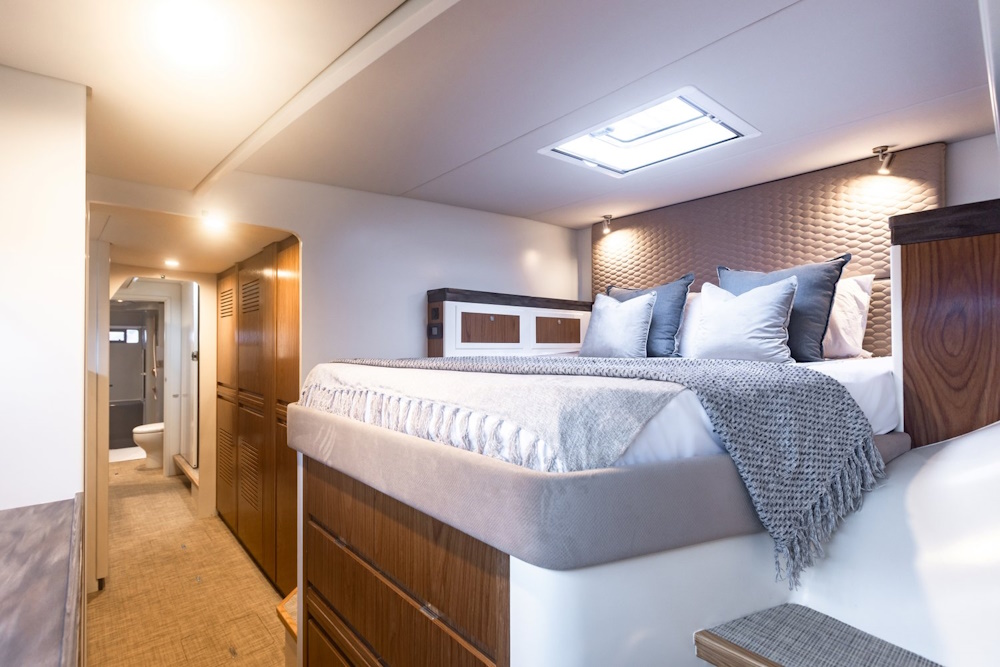
Photo credit: Balance Catamarans
Amanda: “I personally like the hard, top. I know some people don’t think it’s practical and there aren’t that many out there. This particular owner wanted that and I think they’ve done a great job in the design and it looks good. It gets away from having to deal with a Bimini. The downside is that you can’t see the stars when you’re sailing at night.
Darren:” The standard boat set-up is really good. I would recommend the electric winches for most people, they’re so reliable and convenient. That’s an upgrade option that most people get. There’s an option for a Facnor electric winch on the end of the bowsprit and that makes flying the code 0 a single-handed operation.
Amanda: “The Dyneema trampoline as well. It’s higher quality, a better trampoline.
Darren: “Yeah. Fine details.”
Gideon: “Some of the things that Balance does that stand out are things like the solar panels. As you know they use glass because they are more efficient. Some people ask why aren’t there flush hatches, and that’s a maintenance thing. There are things like that that they do a bit differently at Balance. What’s your take on that? “I think it’s quite a point of difference with Balance. It’s not necessarily the latest stuff. It can be the most reliable, or the most efficient.”
Amanda: “Exactly. And 10 years from now it will still look good. It might be frustrating to walk on a deck that hasn’t got flush hatches, but they are reliable and you can replace them easily. You don’t have the drainage problems you sometimes get with flush hatches. “
“We believe in the glass panels after our previous boat which had the stick-on panels. We’ve seen first-hand on other people’s boats that they can degrade quickly, especially in the Caribbean Sun. Even after one year sometimes and yes, it might be covered by the warranty, but do you really want to be replacing them?
Darren: “I think those three things, the glass solar panels, the standard deck hatches and another thing is the glass in the saloon. So all around the saloon, this is all glass, very thick. It’s double-walled for safety. We come from a cruising background, and we know how some things fail in real-world situations. In 10 years, this boat is still going to look and feel like this because of these solid features.
Gideon: “Okay. Let’s talk about the helm quickly because that’s another thing that stands out with the Balance. How do you find the helm set-up? Can you see from both tacks? Can you see and trim your sales on port and starboard tacks?
Amanda: “You can’t see the sail trim on the main 100% of the time. So maybe you have to walk over to the other side, but yeah, once you get used to your boat, she’s an easy boat to trim.
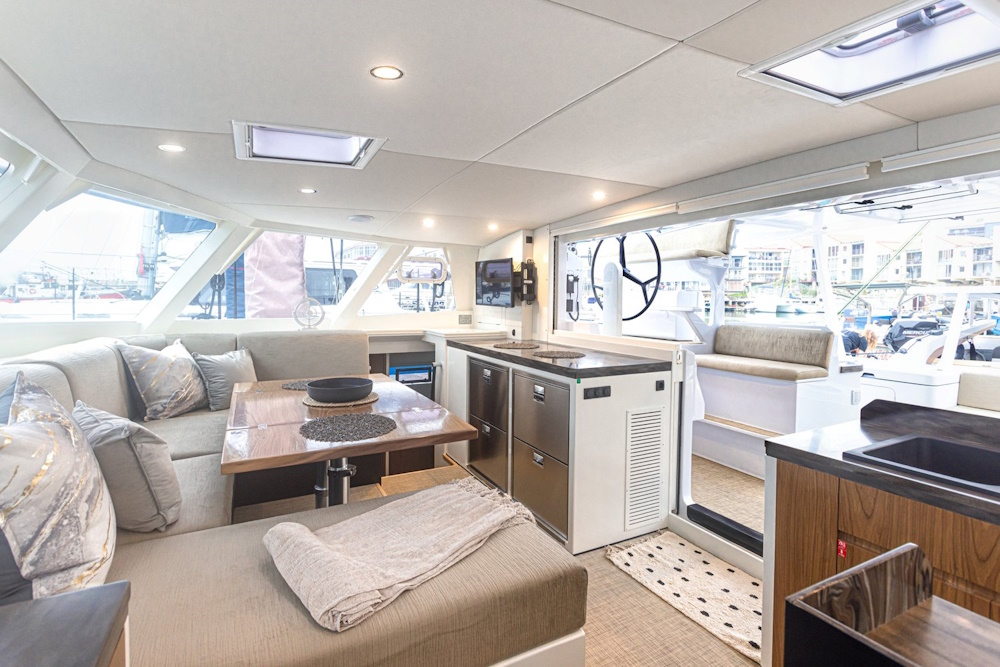
Photo credit: Balance Catamarans
Darren: “The versatility of the helm is exceptional. We had a test sail on the Tuesday after the Cannes show with some journalists on board and a couple of other people, and it was a challenging day. 20, 30 knots of wind and changing weather and we were able to show the Versahelm in real life.”
“So, a big rain squall came through and we were beating up winds. We had water, over the deck and we closed the hatch, came down here, and we sailed from the lower Helm station. And then you’re social, you’re with everyone, and you can still see the Horizon.
So I think this is honestly the best helm solution for a cruising boat, period. Of course, there are pros and cons to every place you put the helm, but for a cruising boat, for a family or a couple going, cruising around the world, I think this is the most elegant solution.
Gideon: “And the bridle system. The main sheet system? Do you enjoy using that?
Darren: Yeah. A-Frame system as we call it.
Amanda: “We were already used to it from our Neel because they used that, so it wasn’t too much of a learning curve. So we’re very familiar with it, and we find it very easy to use and the benefits of not having to rig any preventer, and moving the boom over when you’re on a downwind run, it’s very easy.
Darren: “Yeah, you get a lot of people asking about that. I should say from one perspective, it’d be the racers, maybe people who have come from small boat racing, and they’re used to having that traveller. So in the Puffs, they can just drop the traveller a little bit. And then bring it back up in the lulls. But this is a cruising boat, that’s going to sail thousands of miles across oceans with families aboard. And you’re not going to be trimming down to every last detail hours on end.”
“The A-frame setup is the best cruising setup. With a cat that has a traditional traveller and a single main sheet, you end up having to put another sheet on the end of the boom to act like a preventer when you’re off the wind and the boom starts moving around because of the sloppy sea state in lower winds.”
“So, with this, you have a built-in Preventer anyway, so yeah, I think it’s a hell of a setup. “
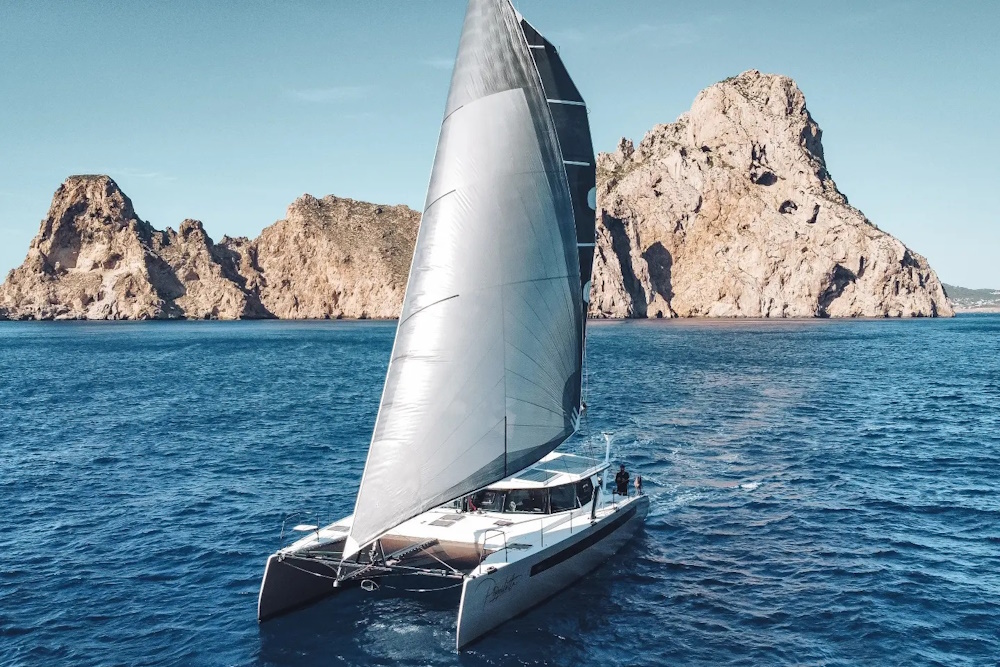
Photo credit: Outer Passage
Gideon: “Touching briefly on the Power set-up (engines). When the wind dies, you’ve got diesels. I know Balance is moving to more of a hybrid solution with their new boats, aren’t they? How is the power set up on the 526?”
“Darren: we’re quite excited about the newer hybrids. I think the standard 526 comes with 45 horsepower, and most people upgrade to the 57 Yanmars because there is no weight penalty. It’s the same engine block and head. It’s just bored out. So you get a little more power for the same weight.”
“So this boat has twin 57s which coupled with the props. They have Gori propellers that have an overdrive function. You can switch the prop blades so that the Leading Edge becomes a Trailing Edge and vice versa.”
“And when it’s switched, you have a prop that going to grab more water for every Revolution. That overdrive function is amazing. So with one engine at 1800 RPM, the boat does six and a half knots at a consumption of four litres per hour or so. I was a charter captain for some time, I worked on Lagoons and Balis and they would never do that.”
“The slenderness of the boat and the lightweight construction all contribute. You don’t need both engines, one engine with overdrive works well. “
Gideon:” Do you need to keep the weight off? I mean does this boat soak it up? If you’ve got guests on board and gear and all the rest of it does it soak up the weight weight? Or do you need to watch it?
Amanda : “I think always with performance multi-hulls you always have to be cautious of weight and distributing it sensibly. But I think she carries her weight very well.”
Darren: “I think with Balance, they anticipate the cruising load with their design and philosophy. People are going to put cruising gear and toys on the boat, so they’re already in that mindset. And I know Phil and Anton, they don’t advertise the lightship displacement, because it’s just not a real world situation. So when they give the weight of the boat, it’s the weight with the rig and sales. She carries her weight very well. Yeah.”
“We’re sitting right now with full tanks because we are about to go on a long passage and we’re going to have four people on board and all their luggage. So she’s sitting a little heavier than we were just before. We took her out for a day sail, and we’re like, oh she’s feeling a little heavier. But it’s not like she took a hit on her performance at all.”
Gideon: “And the layout? Are you happy with the layout, the way that the cabins are organised with the orientation of the berths and everything else? The big shower room aft?”
Amanda: “Yeah, I mean it says something when you’d rather just shower on the boat when you’re at a nice Marina. I’ll be like, well my shower is pretty amazing. It sometimes feels better than a hotel shower. I have hot water, I have space. Like, what else do I need? Most owners opt for the owner layout, because why would you give up that up, right? Yeah, yeah. And the athwartships berth. On our Neel, we also had an athwartships berth. The benefit of this one is that you have an island. You have access to it on both sides.”
“The berths have been awesome. The beds are extremely comfortable. Yeah.”
Darren: “And this is more of a just general catamaran thing, but there are a few other things that we do really like compared to our last boat and that is the galley up and the bridge deck view that you get with these tall windows.”
“That makes for a very open atmosphere, you feel more engaged with your environment. Even sitting here at the saloon, they’ve raised the saloon on a plinth of six inches or so. So that when you’re sitting, you have a clear view of the whole horizon. Um, Yeah, I think that is an awesome benefit in this architecture layout and then the separation of the master hull and the guest hull works really well.”
The fact that you are nearly 30 feet apart, you can have guests and you forget you have guests, you don’t hear them.
Rachel: “So what are your plans, you’ve got your Atlantic passage right?”
Darren: “Yeah, we’re going to the Caribbean. We’re going to go to Lanzarote first and then we’ll go to Antigua on our transatlantic. After Antigua, we’re going to be hosting some trips in the Northern Caribbean, and we’ll be on Pippy through to about March. And then after that, configuring our next boat or signing another contract for a similar set-up as this boat.
Amanda: “We’re going to do a couple deliveries next year, which is kind of a change from our usual program but we’re excited to be able to experience what an owner experiences as well, where we can tell them first-hand, what the delivery was like from South Africa to the Caribbean.”
“How that Handover process looks and the experience in South Africa. We’ve never been. So it’s great Market research for us.”
Rachel: “Keep us posted with your news and let us know. If you’re back in the Mediterranean again, we will catch up for a beer!”
Gideon: “Thanks so much for helping us with the Balance 526 insights! That was good, really useful!”
